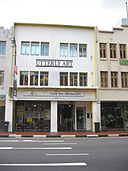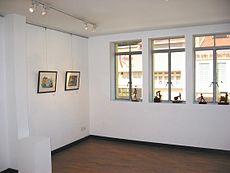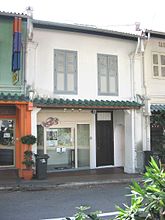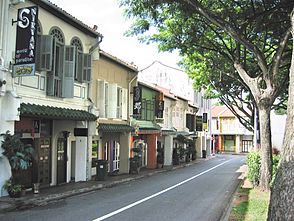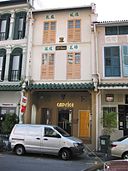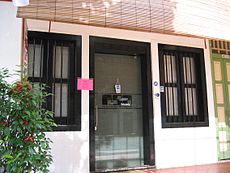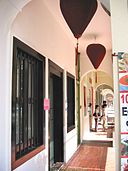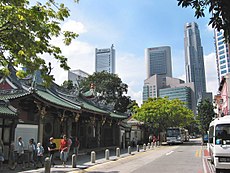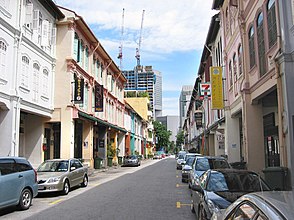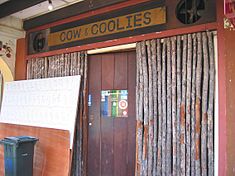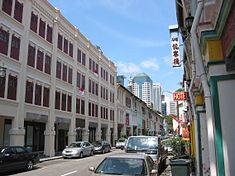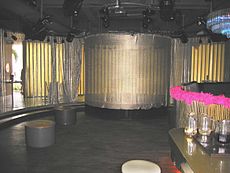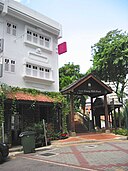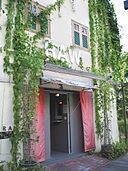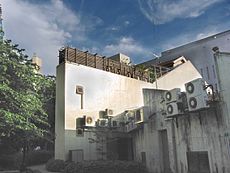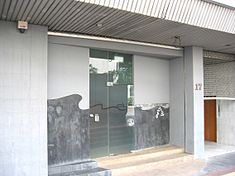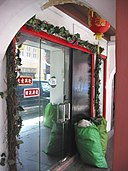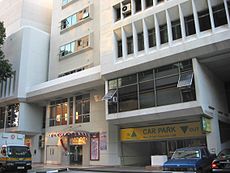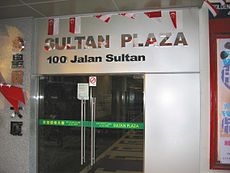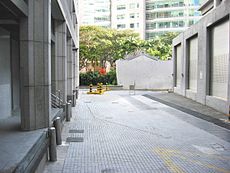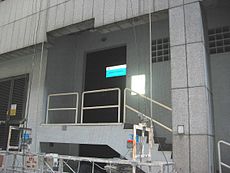This is an old revision of this page, as edited by Groyn88 (talk | contribs) at 06:59, 24 June 2011. The present address (URL) is a permanent link to this revision, which may differ significantly from the current revision.
Revision as of 06:59, 24 June 2011 by Groyn88 (talk | contribs)(diff) ← Previous revision | Latest revision (diff) | Newer revision → (diff)Gay Chinese Singaporean (adults-only photo: & YouTube account:) professional, monogamously attached, although in a relatively open relationship, to his partner of more than 20 years. That's longer than the duration some straight couples stay married. Look at Britney Spears' 45-hour marriage...or should that be 'minutes'? It's downright discriminatory that we cannot get married and enjoy the rights straight Singaporeans take for granted, like HDB subsidies, adoption privileges and spousal hospital visitation rights. Homosexuals are virtually second-class citizens in their own country! Is it any wonder thousands of talented, artistic gay Singaporeans have emigrated over the past few decades to countries where they are not perceived of as criminals and where they are accorded equal respect?
I am an ultra-liberal and I take strong exception to the efforts of conservatives, prudes, neo-Luddites, religious fundamentalists and homophobes to try to curb my, or anyone else's expressive space, as long as hate-mongering is not indulged in. The only freedoms I do not support are immediately destructive ones like guns, nuclear weapons and hard drugs.
- Backup of deleted but important articles
The Future of Homosexuality in Singapore
- Looking beyond the immediate AIDS crisis, it is probable that with the intensive international efforts at developing a HIV vaccine and the discovery that existing drugs like valproic acid are able to wipe out latent reservoirs of HIV infection, a cure for AIDS will be found within a decade. The infidelity of HIV replication which leads to a high mutation rate may delay the attainment of this Holy Grail by several years but even in the most pessimistic scenario, AIDS will become a non-terminal, chronic condition, manageable by cheap generic drugs, much like what type 2 diabetes mellitus is today. This would remove the raison d'être for the current conservative backlash and the liberalisation that was witnessed in the years prior to 2004 would in all likelihood resume its normal course.
- Beyond that, advances in genetic engineering will soon make it possible for homosexuals to reproduce themselves in a true biological sense, by the recombination of haploid chromosomal complements from both fathers or both mothers (the latter already achieved in mice) to produce a child with the characteristics of both parents, and not merely via adoption or cloning. It will then be possible to create a self-sustaining gay civilisation in Singapore where every citizen completely enjoys equal rights.
- Peering even further into the future, Ray Kurzweil, the acclaimed 'restless genius' (Wall Street Journal) and inventor of the most innovative and compelling technology of our era like the Kurzweil Reading Machine, the Kurzweil synthesizer and advanced speech recognition, predicted in his book "The Age of Spiritual Machines: When Computers Exceed Human Intelligence" and his most recent acclaimed work "The Singularity Is Near : When Humans Transcend Biology" that by 2020, computers will exceed the processing capability of the human brain. When this happens, robots will be intelligent enough to replicate themselves without human intervention and perpetuate ever-improving generations of their own kind. This is the event horizon at which memetic evolution surpasses genetics as the dominant mechanism for the transmission of consciousness. Life will no longer be the preserve of organic chemistry. Silicon or other forms of inorganic life will become a reality. Sexual or even biological reproduction will be an option and not an imperative. When the concept of life on Earth itself changes forever, questions such as the morality of homosexuality or of homosexual reproduction will be as passé as the phonograph record in the age of HVD (holographic versatile disc).
Singapore gay venues
Non-commercial/non-sexual venues
It relocated to 56, Geylang Lorong 23, Level 3, Century Technology Building in September 2007. Its former premises were at The Attic at level 4, 21 Tanjong Pagar Road and later at #04-02/04, Yangtze Building, 100A Eu Tong Sen Road, not to be confused with the same unit number at Pearls Centre with which it is intimately linked.
A view of the left portion of the Pearls Centre-Yangtze Building complex from Eu Tong Sen Street.
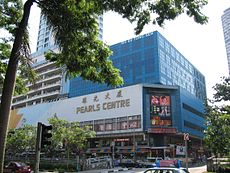
A Singaporean Christian church which welcomes all people regardless of race, religion, gender, sexual orientation or economic status. It conducts Sunday services at 10:30 am.
- Pelangi Pride Centre (PPC)
Set up by activists from Action For AIDS (AFA) to inculcate pride in being gay and in staying HIV negative, it is located at 22a Rowell Road, above the AFA headquarters, in the Serangoon or Little India area.
Its main features are the extensive library of local and international gay literature, whose catalogue can be searched online on its website, and an archive of Singapore gay history and culture. Open once a week on Saturdays from 3 to 7 pm.
Arts venues
The following list consists of exhibition and performance venues where many works dealing with LGBT themes or by LGBT arts practitioners have been held. However, they are not exclusively used for such purposes.
45 Armenian Street, tel: 6337- 7535, fax: 6337-2729, box office: 6337-7800. Founded in 1990 by the late Kuo Pao Kun, it is Singapore's first independent contemporary arts centre, centrally located in the civic district. Its sub-sections include a black box theatre, a gallery, a dance studio, the Blue Room and two multi-function classrooms. It was the venue for the nascent PLU Sunday meetings in the early 90s. The historic PLU 2 pre-registration discussion was also held in the Blue Room in 2003.
- The building at 21 Tanjong Pagar Road
A growing arts, entertainment and lifestyle block managed by Guan Seng Kee Pte Ltd, just next to Ya Kun Kaya Toast. The lift serving the upper floors has a modern interior but is rickety and painfully slow. The building houses the following establishments:
- 1) Space 21
An unrenovated 1950-sq ft art space and multi-function hall situated on level 3, the second home of Utterly Art.
- 2) MOX Bar & Café on level 4.
It is a versatile venue which can be transformed into a bar-cum-function space equipped with lights, sound and platforms to hold events like product launches, birthday bashes and cabaret shows. Tel: 6323-9438, fax: 6227-9647.
View of the exit at MOX Bar & Café.





- 3) The Attic
The topmost floor is a vault-like loft under the same management as MOX Bar & Café. It has a seating capacity of up to 150 people and is suitable for exhibitions, fashion shows and performances. It was the former location of the Sunday services of the Free Community Church (from 2002 to 2004) and Toy Factory Theatre Ensemble (from 2004 to 2005). Currently, it houses Bianco which contains a small bar and has an all-white decor. Dr. Russell Heng's talk When Queens Ruled! A History of Gay Venues in Singapore was held here on 16 Aug 05 as part of IndigNation, Singapore's first gay pride month.


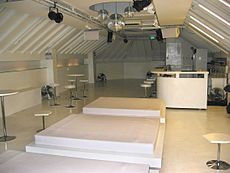 View of the other half of Bianco, showing the DJ console, screen and central row of square bed-rests.
View of the other half of Bianco, showing the DJ console, screen and central row of square bed-rests.
208 South Bridge Road, Level 2 (above Xposé), Singapore 058757. Tel: 6226 2605, fax: 6226-2645, e-mail: utterlyart@pacific.net.sg. It is open from Mondays to Saturdays from 11:30am to 8pm, and on Sundays from 12 noon to 5:30pm. It is closed on public holidays, but open on Christmas and New Year's Eve till 5:30pm.
It provides exhibition space and management services to a diverse and vibrant range of local and Asian artists, and internationally-renowned photographers. The most active gallery on the Singapore art scene, it is a leading showcase of works by established painters like Martin Loh and Chng Seok Tin, as well as popular young artists like Trina Poon.
It was the venue for the very first event of IndigNation, Singapore's historic, inaugural, government-approved gay pride month celebration in August 2005. This was an exhibition of paintings by artist Martin Loh entitled Cerita Budak-Budak, meaning 'children's stories' in Peranakan Malay. The event was followed up with Contra/Diction - A Night with Gay Poets held on 4 Aug 05, Singapore's first public gay poetry reading session which was attended by over 70 people, with standing room only.
Bars, pubs and karaoke joints
(For drag queen performance bars such as the Boom Boom Room and Gold Dust, see the article Transgender people in Singapore).
Most of Singapore's gay bars are located in the Tanjong Pagar constituency, through the heart of which runs Tanjong Pagar Road. This has earned it the nickname of Singapore's Castro Street after its legendary namesake in San Francisco. Gay establishments are found sporadically along Tanjong Pagar Road and adjoining thoroughfares such as Tras Street, Neil Road, Duxton Hill, Ann Siang Road, as well as nearby districts such as Chinatown.
This grand daddy of all gay karaoke joints, along with the now-defunct Babylon, was originally located along Tanjong Pagar Road. It provided divas with an outlet to show off their vocal skills for almost 10 years before drawing its shutters on 24 July 2004. It was later resurrected at 3 Duxton Hill, a stone's throw away from its former location. Tel: 6220-6966.
Ample parking space is available just outside or at the Craig Place building along Craig Road which houses a multi-storey carpark.
A pub-cum-disco originally located in Tanjong Pagar on the left half of where Happy today stands, it was one of the most popular with the trendy young crowd for 7 years since 1997 and attained quasi-icon status.
External façade of Taboo viewed from Neil Road.

It closed in August 2004, only to be reincarnated at 65/67 Neil Road (opposite Tantric Bar and near where Rairua sauna used to be). Tel: 6225-6256.
13A Trenggannu Street (at the corner with Temple Street), Chinatown, tel: 6227-1712.
A cozy, nicely decorated, gay-owned bar, with a balcony for flirting with passers-by. Fridays and Saturdays are particularly jam-packed. The staff are very hospitable and drinks are reasonably priced. It is located close to multiple clubs and gay saunas, opening daily from 7pm until the wee hours.
70 Amoy Street. Gay-owned and staffed, the bar offers room to enjoy cocktails, meet people and indulge in chit-chat.
The decor is modern and warm with natural wood flooring and fixtures. Friendly, professional and attractive staff make one very welcome. It is a nice addition to the local club scene and is close to other clubs and discos. It closed in September 2005.
- Oso café restaurant
145 Telok Ayer Street, opposite Thian Hock Keng Temple, tel: 6323-4642, fax: 6836-0266.
A gay-owned and managed bar serving fusion cuisine, beer, wine, and cocktails. A cosy place for friends to gather, sing karaoke, and spend quality time together. Frequented especially by Chinese-educated bears, it spins good music and has a soothing ambience.
78 Neil Road (across from Taboo), tel: 6423-9232. It is a gay-owned and managed bar, the first to drape a rainbow flag above its main entrance. It has an open courtyard and a great atmosphere with a world music ambience. Weekends groove to the deepest "deep house". It opens daily from 8pm to 3am. The crowd is gay but gay-friendly straights are also welcome.
208 South Bridge Road, #01-01 (in the same building as Utterly Art), tel: 9842-7849. A gay-owned, second home for anyone seeking Prince Charming or looking for a nice cozy place to dine with their dates.
It serves authentic Thai food prepared by Chef Deang, with 20 years' cooking experience, who cooks home-style dishes with a passion. Karaoke starts after 8:30 pm abetted by a great sound system to accompany one's crooning. It especially welcomes bears, chubs and their admirers. Regulars, who tend to be Chinese-educated, chat on EFNET IRC, channel #GAYCHUB@SG.
The management allowed the organisers of IndigNation, Singapore's inaugural gay pride month in August 2005, free use of its premises to conduct the historic, first-ever public talk on homosexuality to be held in an indoor venue since Prime Minister Lee Hsien Loong's 2004 liberalisation of the rules governing these events. The lecture was entitled "Same sex love in classical Chinese literature" and was delivered to a capacity audience by Dr. Tan Chong Kee on 2 Aug 05 .
Lesbian bars
44A Tras Street, tel: 6220 5271. It is one of the few girls' hangouts with a pool table. Week nights are strictly for ladies with Saturday being the only night when male companions are welcome.
It is located on the second floor, accessible from the staircase beside Legend bar. To drive away the Monday blues, it is free pool all night long. Opening hours are from 9pm onwards on weekdays and Saturdays. It is closed on Sundays and public holidays.
95 Club Street, tel: 6325-9595.
Situated in a busy night life area in downtown Singapore, this lesbian-owned and managed bar offers a relaxed, cool, modern style, with excellent music and a friendly welcome. Saturdays are theme nights. It is open daily from 7 pm till late. Happy hours are from 7-9 pm.
30 Mosque Street, tel: 6221 1239.
A pub for womyn to showcase their vocal prowess, belting out the latest Chinese hits.
47 Neil Road.
A karaoke bar run by lesbian owners, it is patronised by a mixed gay and lesbian crowd. It holds soup nights and pool tournaments.
Discos
Opened in August 2004, taking over when Taboo vacated, at 1 Tanjong Pagar Road but incorporating double the space with the takeover of the next-door unit which gives it a sizeable dance floor.
Celebrities and wannabes sip "happysexuals" (their signature vanilla, vodka and lime cocktail). DJ Marvin Kam is in the house. Long queues on weekends.
56-58 Tras Street, very near the Tanjong Pagar MRT station, tel: 6323-3010. Former karaoke pub which was converted into a disco after the karaoke craze died down. Less posturing and more wild dancing than at Happy.
- Cocconuts at Cocco Latte- located at 76 Robertson Quay #01-09, along the perimeter of the Gallery Hotel at Mohd Sultan Road, tel: 6735-0402. 2-storey club with an intimate lounge area on the first floor and DJ on the second. Despite unique features like kitschy decor, striptease poles, flashing neon signs, drink specials and date-matching via number tags, the atmosphere is rather sedate. Open Tuesdays to Sundays. Sunday nights is Cocconuts, a boyz party from 7pm-3 am.
- Club Momo- 5 Magazine Road, Central Mall, tel: 6535-3030. Nearby Clark Quay MRT station. A huge new dance club launched by the former operators of Venom and China Black. Drag shows. Snooker tables. Sunday gay party night. Valet parking.
- China Black- the present reincarnation of Studebaker's/Venom occupying the sprawling 2-storey penthouse on level 12 of Pacific Plaza at 9 Scotts Road, tel: 6734-7677. It has 3 bars, a dance floor, an Oriental theme including teak panelling, Indo-Chinese lamps and Chinese calligraphy wall hangings. Features techno beats and gay anthems, ideal for bare-torsoed exhibitionists itching to strut their stuff on platforms.
- Onyx- at One Fullerton (opposite Fullerton Hotel), Collyer Quay. Nearby Raffles Place MRT station. Formerly known as Centro and the song remains the same: the shirtless worshippers are here to hook up to the beat and soak up the sex, sweat, and muscle. Sunday is their ONS (One Night Stand) gay party night and women are discouraged from entering by charging them higher entry fees.
69 Circular Road, #01-01, tel: 9191-4846.


Singapore's first gay after-hours club spinning progressive and tribal house. RAV decks itself out in a vibrant coat of red and a kaleidoscope of enticing lighting. There is a cozy semi-enclosed chill lounge off to the left of the dance floor. Saturdays and Sundays, 3am to 6 am.
- Located at 17 Jiak Kim Street, tel: 6738-2988, Zouk was built inside 3 warehouses along the Singapore River that date back to 1919. Still one of Asia's trendiest clubs, the interior design was influenced by a mish-mash of styles from Moorish North Africa and Gaudi's Park Guell to Aboriginal art and Turkish baths, with a mix of minimalist furniture, mirrored walls, high-tech lighting and plasma screens thrown in.
- The complex is divided into 4 distinct areas. The flagship Zouk club which is globally renowned with a mainly house and techno policy is a favourite with many gays. It is accompanied by Phuture which covers big beat, drum & bass, down tempo, nu jazz and anything experimental. Meanwhile Velvet Underground aims to achieve an intimate club experience. This is a place for slightly older clubbers with cosy alcoves and comfortable lounge areas as well as a well-stocked champagne cocktail bar. Another section is the Wine Bar, a pre-club bar and chill-out zone with an outdoor seating area and a café offering hot dogs and sushi.
- Zouk club is very organised about who is spinning on which dates. The best time to meet gay folks is when guest DJs are in attendance, so the schedule on their website should be checked. However, because of the upscale, mixed crowd, discretion is warranted. Packed on Fridays and Saturdays. Wednesday is the Retro day, although not really that gay. When big-name international DJs perform, one should arrive between 7-9pm to get cheaper tickets as prices rise after 9 pm.
Saunas
45 Ann Siang Road #02-02 just behind Maxwell Food Center and a 5-min walk from the Tanjong Pagar MRT station, tel: 6222-2252.
The third sauna established by entrepreneur Max Lim in 2003, its competitive advantages are its budget entry fees, 24-hour opening times and a 'barracks' containing individual rooms for those desiring to stay for prolonged periods. It pioneered the concept of theme nights, which later spread to all saunas. This introduced variety and catered to subsegments of the gay crowd such as chubs, foam party lovers, minority races, foreigners and sun worshippers. It also experimented, for a short period, with an à la carte restaurant on the ground floor, a transvestite cabaret and male undergarment/swimming trunk fashion shows. It was the only sauna to proudly hang a rainbow flag, an LGBT icon signifying diversity, outside its main entrance. It is located next to Ann Siang Hill, already a popular cruising ground. Membership is no longer required.
An upmarket sauna at 17 Upper Circular Road between Boat Quay and Clarke Quay. The Raffles Place MRT station is closest. Tel: 6223-0017.
Nude nights start on Friday from 7pm till Saturday morning. Saturdays from 7pm to midnight are 'short towel', and after midnight it is 'skin'." It was the first to have an al fresco swimming pool which later had to be covered up, as office workers in the neighbouring building could have a bird's eye-view of the frequently naked men lounging around the poolside. The floor above, which was formerly occupied by a bank, was acquired and renovated at great expense in 2004 which effectively doubled its cruising space. Two men were arrested here by undercover policemen for homosex in 2003. Their penalty was commuted from a potential 2-year jail sentence under section 377 of the Singapore Penal Code to a mere $600 fine under section 20 of the Miscellaneous Offences Act in what may be a landmark ruling in Singapore legal history, as far as gay rights are concerned.
6 Loke Yew Street. The City Hall MRT station is the nearest. Tel: 6336-6328. It has private suites, group areas, a steam room, jacuzzi, hydrojet cool pool, café and private sun deck. Open Mondays to Fridays from 4pm and on Saturdays and Sundays from noon. The crowd is a mix of locals, expats and visitors. It is billed as Singapore's largest gay sauna and also the most expensive. Its monthly nude "full moon parties" held once a month on the 15th day of the Chinese lunar calender, and youthful attractive patrons are the greatest attractions. It has been consistently ranked as the most popular sauna in Singapore through various polls.
7 Mosque Street, near Chinatown, tel: 6221-2729.
A 3-level sauna appealing to a mainly Chinese-educated clientèle. It has the most nude nights in a week, on Fridays, Saturdays and Sundays.
182 Telok Ayer Street near Tanjong Pagar, tel: 6221-0367.
The Box was Singapore's first cruise club, a concept which proved less popular locally, so it was later converted into a sauna. It was one of the last saunas to introduce nude nights. No membership is required.
2 Jalan Pinang, near Bugis Junction outside the CBD. Parking is available at the Golden Landmark Hotel. The Bugis MRT station is closest. From here, it is a 5 min walk in the direction of Sultan Mosque. Tel: 6295-5668. Established by a naturalised Frenchman, it has a full gym, a café with free Internet access (the first gay sauna to offer such a service), and a large steam room. The entrance fee is inexpensive and no membership is required. It is patronised by a crowd of all nationalities. Nude nights are on Sundays; Thursday nights are for 20-somethings only. Another 4 men were arrested here in April 2005 in a police raid masquerading as a night-time fire-safety inspection. The outcome of this case is still pending amidst the apparent official backlash against the rising incidence of HIV infection amongst homosexuals in Singapore.
05-01, Sultan Plaza, 100 Jalan Sultan near its junction with Beach Road, tel: 6392-2396. It is unique amongst gay saunas in that it charges a standardised entry fee of $19 and that it closes relatively early even on weekends.
It started as a straight sauna offering massage by women masseuses, but gradually gained a predominantly gay, elderly Chinese-educated clientèle. This phenomenon of homosexuals eventually forming the majority of patrons in a previously straight establishment is affectionately locally known as "colonisation". It was the first sauna to have a coin-operated karaoke machine on its premises, free buffets and Hollywood/Hong Kong movie screenings, all of which proved to be very popular. It closed in early 2005 for renovations and reopened for business on 29 May 2005 with a relocated entrance but has, since the latter date, been patronised mainly by elderly straight Chinese customers, making it more of a mixed sauna again. Recently Wednesday nights have been promoted for chubs and their chasers, with this phenomenon spilling over into the weekends.
Outdoor venues
Being frequented mainly at night by a stigmatised minority in fear of running afoul of the law every time they congregate for social or sexual intercourse, outdoor gay hangouts have remained largely unknown to the mainstream public. It was only in the mid-90s that police harassment of homosexuals at these venues stopped, although sporadic complaints by members of the public may still be investigated. The following list, which includes cruising areas some conservative gays may feel does not cast a favourable light upon the Singaporean homosexual image, has been drawn up for the sake of academic comprehensiveness and as a record of the collective local gay memory.
(For transgender (transvestite/transsexual) venues such as Bugis Street, Johore Road and Changi Village, see the article Transgender people in Singapore.)
Also officially known as Hong Lim Green, it was the first and formerly the most famous Singaporean gay venue listed in the première international gay tourist reference, the Spartacus Gay Guide. It was affectionately code-named "Honolulu" or "Hollywood" in the early years by some English-educated gay men. Later, after the fame of the movie, others also nicknamed it "Jurassic Park" as an irreverent dig at the geriatric homosexuals who frequented the place. Cruisy at night for more than half a century, its dim lighting and tall shrubbery provided ideal conditions for quickies between gay men, especially elderly Chinese-educated ones, until the bushes were pruned and bright lights installed in the early 90s to deter such activities. Nightly cruising and sex also took place in a small 2-storey shopping centre which was demolished and replaced by the present car park. The setting-up of the Kreta Ayer Neighbourhood Police Post in an old building next to the car park was also considered a measure to curb late-night cruising. Straight patrons were shocked at some young boys holding hands and wrote letters to the newpapers in the 80s to complain. In spite of several police patrols in which these boys were questioned, no one was charged as nobody was caught flagrante delicto. Photographs:


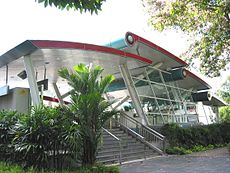



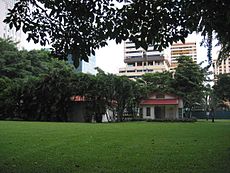




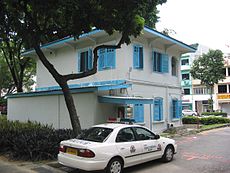
- Fort Road Beach- a secluded stretch of reclaimed land near Fort Road in Tanjong Rhu, visited by gay men since the 1980s. Nude sunbathing or swimming sometimes takes place as it is remote from public view and no one is disturbed. Its future as an idyllic gay venue is uncertain as development plans may bring it into direct public access. Less frequented stretches of beach include the more secluded areas near Changi Point which in the past were occasionally visited by heterosexual Gurkhas and Korean construction workers who served as the draw for local gay men, the segment of East Coast Parkway near Big Splash and the area near the People's Association chalets.
Cruisy at night since the early 1990s, but much less so since a landscaped sanctuary named Ann Siang Hill Park was built in 2004 with adequate illumination so that clandestine activities are not so convenient.




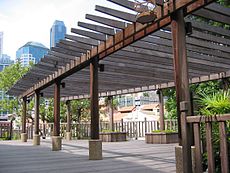
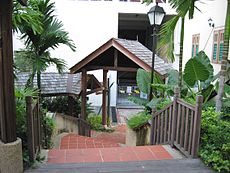
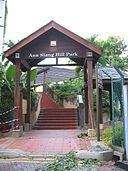
- Back alleys in the Central Business District and Tanjong Pagar

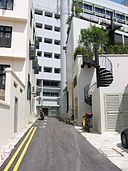
Less popular after the sprouting of numerous gay saunas since the late 1990s and the development of well-lit commercial complexes like China Square which replaced the dark, dank, derelict shophouses where night-time cruising took place.
- Katong Park- the previous toilet which was completely enclosed by 4 brick walls was a hive of activity. The new toilet, built in 2003 during a major redesign of the park, whose interior is visible from the outside via large gaps in the slotted timber walls is much less conducive to cruising, although some still takes place. Most homosexuals prefer to stroll in the fresh air along tracks traversing and skirting the perimeter of the park.
Enclosed/Indoor public venues
More comprehensive and up-to-date listings can be found at the Utopia website's Singapore pages:
- Toilets
- Swimming Pools
- Shopping Centres
(For a discussion of places no longer extant where homosexuals used to socialise or cruise such as Le Bistro, Pebbles Bar, Treetops Bar, Vincent's lounge, Niche, Marmota/Legend/Shadows, Spartacus, Rairua, Boat Quay and Esplanade Park, see the article Singapore gay venues: historical).
Singapore gay venues: historical
Introduction
Before the relative liberalisation of Singaporean society, local gay culture consisted solely of venues, largely unknown to the mainstream public. Prior to the 1980s, there were no publicly "out" homosexuals, no Singapore gay organisations, no Singapore gay literature, no Singapore gay art, no Singapore gay films or anything remotely "gay" apart from surreptitious nocturnal congregation spots. Thus, the following list forms an integral part of the documentation of Singapore gay history.
Bars
- Le Bistro- Singapore's first gay bar which opened in the 1960s, as far as many gay Singaporeans can recollect. It was located at the basement of a landmark building called Tropicana along Scotts Road. The latter was a 4-storey entertainment complex renowned for its topless dancing girl revues and occupied the exact spot where Pacific Plaza now stands. Le Bistro was a well-known chill-out bar, especially amongst English-educated gays, and a reputed pick-up haunt for white tourists and local, deeply-closeted homosexuals. Gay gatherings began on Sundays, a tradition which grew out of earlier attempts by Singapore food and beverage outlets to copy an American practice current during that era of Sunday afternoon tea dances. During that time slot, bars and discos were officially closed but Le Bistro's owner would admit his "friends" for a private party. As numbers grew and confidence increased, the afternoon tea parties eventually took over the Sunday nights. One retired New Zealand serviceman, in a chance encounter with Alex Au, claimed that in the early 1960s when he was stationed in Singapore, there was a Golden Venus bar in the Orchard Hotel along Orchard Road. This claim has not been corroborated by Singaporeans. The old Orchard Hotel has since been reconstructed beyond recognition. Le Bistro and Golden Venus no longer exist.
- Pebbles Bar- located on the ground floor forum of the now-demolished Hotel Singapura Continental along Orchard Road, it was the most famous gay bar operational in the 1970s. It was patronised largely by the English-educated, upper-strata gays of Singaporean society and spawned many a local-Caucasian pairing. Its main draw was the live band Tania, whose lead singer, Alban de Souza, was decked out in glitz, painted his face à la KISS but with red makeup instead of black-and-white, and entertained with energetic camp. Although it was the only one of Singapore's first 3 gay bars to have a dance floor, no homosexual dancing was allowed. So gay people sat in one half of the bar drinking and listening to the music, while watching the straight couples dance in the other half. However, it was a common sight to behold men pecking each other on the cheek or lips, incidents which raised nary an eyebrow.
- Treetops Bar- located at the now-demolished Royal Holiday Inn along Scotts Road. Gays also adjourned to Café Vienna after a night of hectic discoing in the 1970s. However, after several years, the proprietor of Treetops Bar felt that having a sizeable gay clientèle was bad for its image and discouraged their patronage.
- Babylon- Singapore's first exclusively gay karaoke pub at 52 Tanjong Pagar Road, set up during the height of the karaoke craze in the 1980s; a narrow, miniature version of its legendary namesake in Bangkok and the original Sumerian city.
Opened on 18 May 1989 at #06-05 Lucky Plaza, 304 Orchard Road, former tel: 7361360, it was the first East-meets-West pub where Asian potato queens, a large proportion of whom were Malay, could meet up with their Caucasian aficionados, otherwise known as rice queens. It offered karaoke as well as booze. It relocated many years later, shortly after its 14th anniversary in May 2003, to a street-level shophouse at 15 Duxton Road in Tanjong Pagar, renaming itself Vincenz.
File:Vincenz001.JPG
File:Vincenz002.JPG
It contained a handsomely elegant wooden bar which offered a large selection of beers on tap. The establishment was called "Venerable Vincent's" and "The Grand Dame of Singapore" for good reason. The newer outlet closed down on 26 March 2005 after 16 years of promoting East-West relations.
Discos
Originally catering to a gay customer base only once a week, usually on Sundays, newer small establishments have managed to survive on the burgeoning pink market by going full-time, on every night of the week.
- The Hangar- Singapore's first gay pub-cum-disco located in a hard-to-find alley along Upper East Coast Road near Bedok was operational in the early 1980s. One had to trudge along a length of unpaved road up a mild slope to gain access to the bar, which was housed in a whitewashed, single-storey, elongated, dormitory-like house. Looking back, some patrons presently in their fifties could not imagine how they could have grooved to the now seemingly uncool hits of that era like 'Beautiful Sunday' by Dawn.
- Marmota/Shadows/Legend- located on the second level of Kallang Leisuredrome above the bowling alley and operating in the early to mid-1980s, it was one of the first to hold regular Sunday gay nights. One would find the dance floor packed with the then-unusual sight of men dancing with each other. However, this happened only during the fast numbers. When the slow songs came on, the dance floor cleared faster than as if a tsunami threatened and only the daring ones irresistibly smitten with their partners were left in tight embrace to be ogled at by those on the sidelines. It was the first disco to organise unofficial masculine Mr. Gay Singapore contests long before Manhunt began. Ironically, the first winner of the contest was a straight boy named Oliver. The disco underwent several renovations and name changes over the years.
- Niche (at Far East Plaza)- opened in April 1983 to cash in on the popularity of Marmota. More popular with the English-educated crowd. It spawned a popular latter-day namesake at Pagoda Street in Chinatown. This second incarnation had its liquor license withdrawn in 1989 and was given only a week to close down. No reason was provided for the police action but a person, personally involved in the running of the disco, believed it was a reaction to the first reported case of an AIDS death in Singapore.
- Studebaker's/Venom- situated at the top floor of the present Pacific Plaza along Scotts Road was the largest disco that homosexuals had ever experienced in Singapore. It remade its image several times over since the early 1990s to remain fresh and introduced webcams where people could see who was dancing in real time by logging onto the Internet. Needless to say, this raised a howl of protest.
- Music World- 2-level disco in Katong Shopping Centre along East Coast Road, operational in the early 1990s.
- Centro- one of Singapore's largest discos at One Fullerton (opposite Fullerton Hotel), Collyer Quay with Sunday gay nights. It opened in 2003 but closed in 2005 to be succeeded by Onyx at the same location but under a new management.
Saunas
Before the 1990s, local homosexuals had to journey all the way to Bangkok, Thailand to experience the pleasures that gay saunas offered. It became more convenient in the early 90s when an establishment called Ryu, meaning 'dragon' in Japanese, opened in Taman Pelangi near the Pelangi Complex in Johor Baru, Johor, Malaysia. Hot on the heels of its overwhelming success in attracting huge crowds of both Singaporeans and Malaysians, another gay sauna called New Blue Boys opened at 104 A-B, Jalan Serampang, Taman Pelangi, 80400, Johor Baru about a year later. Some Singaporean gays would charter taxis in groups to traverse the causeway and experience what was sorely lacking at home.
The first gay sauna in Singapore opened in 1997 by pioneering entrepreneur Max Lim. It was 3 storeys of hedonism, with a daily gay disco on the ground floor fringed by an overhead observation deck, and showers, a gym and sauna above that. It was strict about sex at first, displaying signs which read, "No obscene acts allowed", but the rule was gradually relaxed after everyone realised that the police did not bother to harass its patrons. The sauna could be recognised immediately from its external façade because of its colossal signage and the painted sketches of nude gladiators on its external wall facing South Bridge Road, near its junction with North Canal Road.
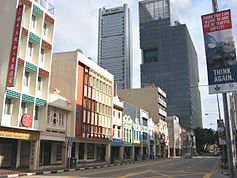
It experimented with the novel concept of giving its customers the option of buying shares in the business. It also pioneered services like offering upmarket buffet meals on its premises, but unfortunately, demand for the meals and disco was poor, even though the spa facilities were a resounding success. It closed in late July 1999 due to high rental costs and other factors.
Advertisement for Stroke sauna, the first to open 24 hours a day.

The successor to Spartacus under the same management, located at 22 Ann Siang Road, it had a spell of success from 2000 to 2002 when it was the only gay sauna in Singapore and also the first to open 24 hours a day, all year round. The opening of other gay saunas to break its monopoly forced its owner to move into newer premises to refocus its strategy two years later.
A multi-level sauna along Neil Road, the brainchild of activist Alex Au, it opened in 2002 and positioned itself as Singapore's first luxury gay sauna, with prices to match.
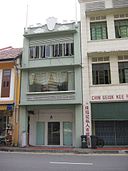
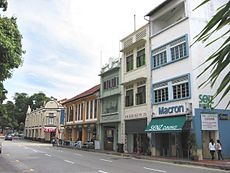
It pioneered Singapore's first 'skin nights' touted as 'all nude, all floors, all night', a concept that unexpectedly proved so popular amongst supposedly 'conservative' Singaporean gays that such nude nights spread to all saunas within the span of one year and continue to be a major draw. It also organised special events like cultural talks, personalised photography and naturist art sessions, and erotic dancing by showerboys. Unfortunately, due to the expiry of its lease and disagreements with its landlord over maintenance, it closed down in April 2005.
Outdoor venues
One important principle which has governed the peculiar locations of contemporary outdoor cruising areas is the "gentrification-induced shift" phenomenon. Older areas which had been patronised in the past had to be abandoned as urban redevelopment caused the destruction of conditions conducive to cruising such as poor lighting, sparse human traffic and the presence of dark, derelict buildings/environs. Thus, the present siting of cruising areas in the Ann Siang area may be explained by the gradual shift of activity from Boat Quay to the China Square vicinity to Ann Siang Hill as these areas were successively gentrified. To some extent, a "shopping centre/public building shift" was likewise induced by redevelopment eg. from Plaza Singapura to the former National Library to Raffles City.
- Boat Quay and the adjoining back alleys parallel to the Singapore River's west bank
Very cruisy at night before the area was rejuvenated with the present row of restaurants in the early 1990s. Police patrol cars would occasionally drive up and record the IC numbers of gay men who were doing nothing other than chatting with each other, a form of intentional harassment.
Boat Quay by day.
Boat Quay by night.



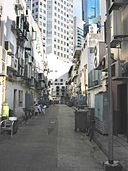

Surreptitious sex also took place at the foot and back alley of OCBC building nearby, before bright lighting was installed which serves no real purpose other than to deter nocturnal homosex.
Areas surrounding OCBC building such as the Raffles Place MRT station and the construction sites of buildings on the other side of Philip Street were also popular and gave rise to the novel phenomenon of car-cruising. Unattractive cruisers could increase their chances of picking up handsome gay pedestrians if they drove big flashy cars.
The streets traversing China Square, namely Hokkien Street, Nankin Street and Chin Chew Street were overrun especially on weekend nights by gay men and car-cruisers when the whole area was lined with abandoned, dark, derelict buildings in the 1980s. Many would stand or sit along the corridors of these dilapidated buildings and people-watch, chat, fondle each other or step into passing cars.
- Esplanade Park- the whole area between Queen Elizabeth walk and Connaught Drive was lined by bushes enclosed in tiled rectangular stone enclosures where strollers could sit and chat before the present arts centre was built in the early 2000s. It was frequented for decades by especially gay young men who acted more girlishly than usual to attract straight pick-ups for the night. Others came looking for South Asian men, of which there were many. Some activity also spilled over into The Padang, which at night, was mainly the territory of straight couples making out on mats. Other parks which were relatively cruisy but less well known in the 1970s were Central Park, accessible via the long flight of steps up from River Valley swimming pool, Fort Canning Park nearby, Labrador Park, accessible only by car or motorbike, Mount Faber, the Botanic Gardens and MacRicthie Reservoir.
Indoor public venues
- Toilets- public toilets have their fair share of furtive homosex. Some of the historically popular ones which no longer exist were those near Hong Lim Park, at the former Odeon cinema where Orchard Cineleisure now stands, along Balestier Road next to the open market and at the former National Library along Stamford Road.
- Swimming Pools- the most notorious one no longer extant was River Valley swimming pool. It was one of the few public pools built in the city area, sandwiched between Liang Court and the imposing backdrop of Fort Canning Park. In one incident, two men were caught by the lifeguard for underwater fellatio and jailed. It was also one of the few swimming pools where outdoor photography was banned. Less well known were Yan Kit swimming pool, Jurong swimming pool and Bukit Merah swimming pool.
- Shopping centres- the upper levels and toilets of Plaza Singapura and Serangoon Shopping Centre were popular cruising grounds during the 1980s.
Singapore gay venues: historical, minor
Introduction
The following establishments constitute a chronicle of the relative non-successes amongst the efforts of Singaporean gay entrepreneurs to carve a profitable niche in the limited pink market. Some of these businesses may have closed for reasons other than cash-flow problems, so it may not be fair to label all of them as 'failures'.
The factors that prevented them from taking off may have included poor location, small size, inadequate facilities, high rent, lack of focus, insufficient advertising, incorrect pricing, undifferentiated service, partnership disputes and many others.
It is hoped that after a decade of recording these establishments, a meta-analysis of the factors which led to their demise may be made and be instructive to future gay entrepreneurs.
Pubs, Bars and Karaoke joints
01-01, Craig Place, 20 Craig Road, former tel: 6383-8122.


Saturday night men's party. Even though it was located in the heart of Tanjong Pagar, it was not very popular, probably due to the presence of larger, well-established bars and discos all around. It opened in 2003 and closed down in 2005. The location has been taken over by an establishment called Freeze.
Lesbian venues
20 Upper Circular Road, #B1-01/06 The Riverwalk, former tel: 6536 1386.


Located across the road from Boat Quay, the pub came alive every Friday night with Top 40 and R&B hits, a packed dance floor and al fresco area. It was a good bet for an action-packed girls-only night out. It opened in 2003 and closed in 2005.
Spas and Saunas
- Papillon- A gay sauna along Keng Cheow Street in Robertson Quay. Its small size and location away from the gay-frequented districts of Tanjong Pagar and Chinatown were probably instrumental in preventing it from achieving mass popularity. According to some patrons, it also had no toilet! It opened in 2004 and closed after only a few months of operation in mid-2005.















